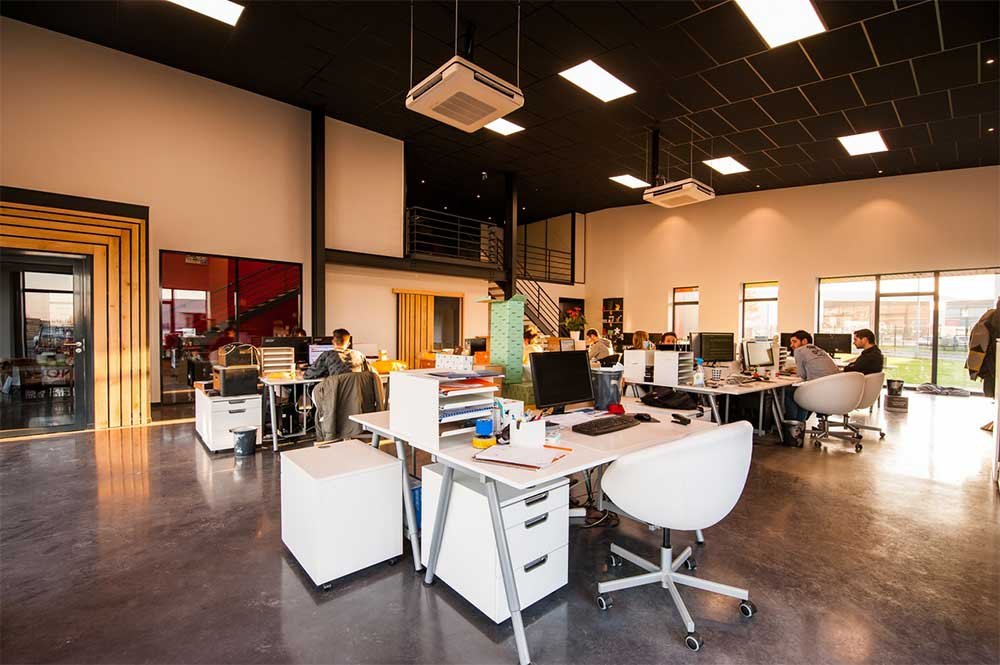It’s a common notion that an open office increases collaboration and productivity, saves costs, and improves meritocracy.
However, there is a debate on whether open space offices help employees to be more collaborative or not.
Reasons Why Organizations Implement Open Office Architecture
A study done by Future Workplace shows that 55% of Gen Z and 56% of Millennials prefer working in open offices. They are more collaborative than the other generations, and they can work well even with a lot of distractions.
Therefore, the younger the employee, the more they are willing to work in an open office setting.
Open offices seem to improve the relationship between employees, management, and business proprietors leading to a better working environment.
Open office architecture is economical as it utilizes less space, accommodates more employees in a smaller area, and lowers office maintenance costs. It is much easier to redesign an open office than a closed one.
Your employees are your primary focus, and they should have comfortable working experience. The open office setting is believed to increase productivity as employees can relate well and work more as they are in the open where everybody can see each other.
It is also believed to increase communication by bringing employees closer together without wall barriers, which hinder face to face communication.
Such a layout improves consultation and exchange of ideas when working on shared projects as the employees have easy access to everyone, no matter the rank.
For those in higher positions, it can improve and streamline management as it offers close supervision and a direct communication channel for feedback delivery and enables a clear overview of the progress.
Setbacks Associated with an Open Office Setting
Despite the benefits associated with open office settings, some setbacks may arise from it.
An open office is prone to noise pollution, especially when employees start talking together either on their phones or platforms such as Skype.
Such issues lead to reduced job concentration—there are a lot of distractions from either the noise or from the colleagues.
Open offices reduce privacy—every conversation is laid out bare for everyone in the room to hear. They can be a health hazard in times of flu as employees are closely together enabling ease of transmission.
There is also a high chance of workplace conflicts due to the absence of hierarchy and disagreements between employees.
Research Reveals a Downwards Trend in Collaboration
Studies done by two researchers—Ethan Bernstein and Stephen Turban— from Harvard shows that open office seems not to be conducive to collaboration meritocracy.
They gathered and analyzed data from two Fortune 500 multinational companies in a traditional closed office setting and after they transitioned into open office design.
With the aid of modern technology, they were able to monitor the collaboration anatomy by analyzing the communication flow.
Using sensors and cameras, they tracked the employees’ movement, the time spent at their desk and one on one interactions in the workplace.
The data collected in their study showed that one on one interaction between employees dropped by 70% in the open office setting.
Additionally, they also monitored digital communications such as emails, instant messages, calls between employees to determine how it changed after the move to open office setting.
Variables such as seasonal business cycles, data collection period before and after the shift to open office were factored in to ensure the results were unbiased.
Surprisingly, digital communication increased when the companies moved to open office architecture.
Employees were now sending 57% more emails and 67% more instant messages than before the shift.
Employees started using technology such as noise-canceling headphones to counter distractions associated with the open office setting.
Additionally, they turned to simpler communication apps like Slack and other messaging apps, thus minimizing direct communication as much as possible.
Why has collaboration declined in open offices?
Denis Diderot, a philosopher from the 18th century, told performers to imagine a huge wall between them and the audience as if the curtain never rose.
By doing that, the performers were able to get fully immersed in their acts without distractions from the audience.
Collaboration in an open office setting depends on the individual’s or organization’s culture.
If an employee reacts with an annoyed face when bothered, others will restrain from communicating altogether. Such virtual boundaries are the reason communication in open offices is actually lower than in other office layouts.
Employees in an open office must create a wall—set personal boundaries that are respected by the workmates.
Employees should avoid bothering other workmates when they are busy. They must learn proper office etiquette that governs how they communicate with each other, but they will need some guidance on this.
How you can improve collaboration and meritocracy in open offices
Open office culture can be improved if employees are allowed to choose where they stay anytime they come into the office. Some ways you can help improve collaboration is by:
Empowering your team
You can allow the team to set their own office rules and goals so that they can create an environment where they are comfortable to work.
If you allow them to do so, they will accept the open office setting better, and it helps to increase collaboration and morale.
You should analyze how your employees interact to devise ways to improve collaboration in your open offices. You can use sensors to track movement and face to face communication of your employees.
Being adaptive and flexible
Open offices should offer employees multiple options for workspaces to accommodate collaboration needs and different working styles.
Provide open gathering spaces, private phone booths to give your employees the option to get away from the noise.
Switching your office layout to modern designs that have a little bit of everything—open collaboration spaces and private nooks for focus—will help prevent noise and distractions for those employees who need to focus on their own thing.
Such a combination layout enables and improves privacy while still promoting communication.
Such modern layouts ensure that every employee has all they need at their location to complete their tasks efficiently.
Adopt new cultural norms
Adapt your office cultural practices to improve collaboration in an open office setting.
For instance, employees can start using a “do not disturb” sign or a light on their desk, which informs the colleagues when one is open for one-on-one interactions.
You can invest in technology such as communication equipment, projectors, and phone booths to improve the employees’ experience and make them more comfortable.
The employees adapt to new cultural norms naturally, thus increasing interactions in open offices.
Create a process to solve issues & complaints
Whenever complaints and conflicts arise, they hinder collaboration in the workplace.
One of the main conundrums of the open office setting is not knowing who to report your problems to.
Most employees report that they don’t know where to ask for help in open office architecture.
Have a clear issue reporting and solving process to rectify such situations quickly when they come up. That way, you will eliminate downtime caused by disruptions.
It’s not enough to have this process. Your employees should be aware of the process, and you should have an “open door” policy towards reporting problems. Focus on how to solve the issue, not on whose fault it is.
Open Offices are Not Conducive to Collaboration
While highly praised and popular, open offices seem to bring down collaboration instead of helping improve it.
This is mainly due to noise, distractions, and poor communication, which stems from the incompatibility of business practices and organizational culture with the open office layout.
An open office can still work well with a few improvements in policies and culture. Give your employees the freedom to choose open or closed spaces, adapt your culture, and have a system on solving issues and conflicts.

